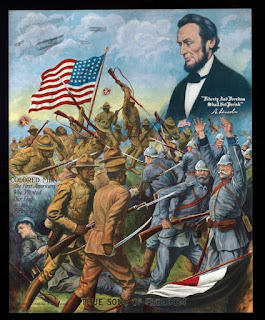True Sons of Freedom
 |
| "True Sons of Freedom," chromolithograph created by Charles Gustrine, United States, 1918 |
 |
| ‘All hail the world October revolution!’ – a poster from 1933 |
The US
entry into WW1 prompted a call to arms for a very segregated and dysfunctional American
society. Colored people still faced racial discrimination and violence at a
large scale; extra judicial killings were a lived reality for black Americans
along with immense economic and social barriers. In this atmosphere, US war
propaganda to recruit colored men and women into the war effort, such as the
above displayed poster, fell nothing short of ironic. Colored men who did not have basic economic
and social freedoms were being called ‘True Sons of Freedom’. This hypocrisy
was not lost on people like Claude McKay who looked elsewhere in the world for
a greater sense of being than that which existed in the US.
McKay’s
experience in Soviet Russian under the hype of communist internationalism is
starkly different from his lived reality in the US, for the first time, as sir
said in class a person of color has the experience of being a somebody rather
than a nobody. Instead of having his existence just allowed or tolerated, his
existence is welcomed and celebrated, and not just that he is also given privilege
something someone of McKay’s color would not have experienced, “Wherever I
wanted to go, there was a car at my disposal. Whatever I wanted to do, I did.
And anything I felt like saying I said. For the first time in my life I knew
what it was to be a highly privileged personage. And in the Fatherland of
Communism!”
The
picture that the Soviet propaganda posters paint is not very far from the on
ground reality of what the Soviet Utopia is like, accounts like Dada Amir
Haider’s and McKay’s are testaments of this. The US propaganda came out of a
necessity to have colored people involved in the war effort, but when their
participation was not required anymore, all the rhetoric about ‘the first
Americans’ and ‘True Sons of Freedom’ disappeared. Even within the American
Communist Party as McKay rightly pointed out the representation of black people
is tokenistic and a means to gain their support without giving them any real
power or agency to voice the needs of their own people , “The Republicans and
the Democrats do the same thing. They give a few plum places to leading Negroes
as representatives of the race and our people applaud vicariously.”
In the
Soviet Union the reality was quite different, Claude McKay had the freedom to
say what he wanted, and was often given the platform to voice his opinion even
at the displeasure of higher ups in the communist party like Zinoviev. The Soviet propaganda did not merely come out
of a need for the involvement of the colored people of the world in the
proletarian revolution, rather the very ideology on which this ‘propaganda’ was
based on saw colored people from the same lens as white people and actively
desired their equal involvement in the struggle. As Dada’s travelogue details,
many of the students at the university were trained to start the communist
struggle back in their countries, their struggle was not coopted by the Russian
revolutionaries, and rather they were seen as competent enough to lead their
own revolutions hand in hand with revolutionaries elsewhere in the world as the second poster shows.
“We hold
these truths to be self-evident, that all men are created equal, that they are
endowed by their Creator with certain unalienable Rights, that among these are
Life, Liberty and the Pursuit of Happiness.”
While
these words are a part of the American Declaration of Independence, they were
more applicable in the Soviet Utopia than they were in McKay’s USA begetting the question, who really were the true sons of freedom?
Comments